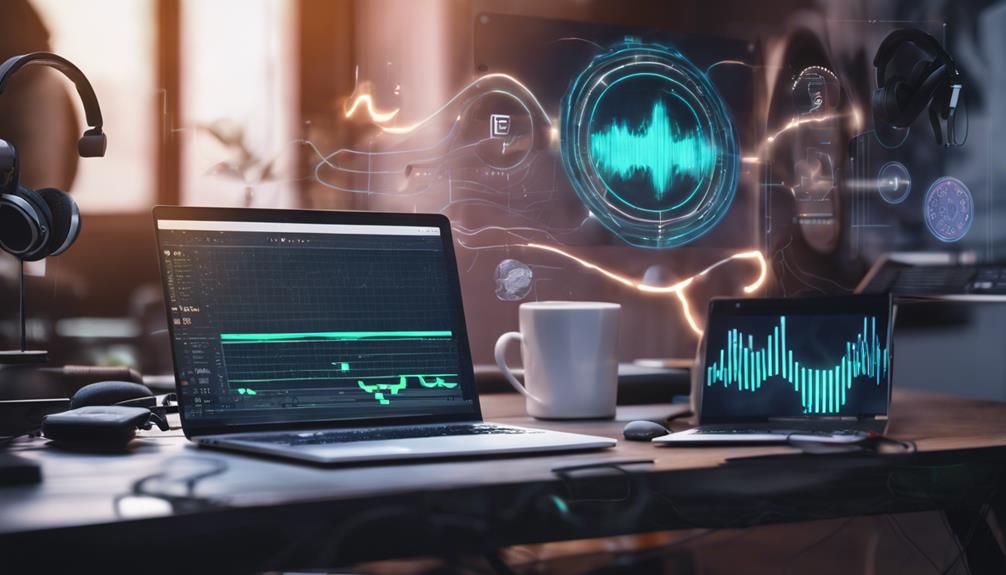Using AI technology to transcribe Vietnamese audio into text is a game changer for efficiency and accuracy. With advanced algorithms and machine learning, these tools capture your spoken words and convert them into digital text, while recognizing the nuances of various dialects. Notably, they save you time compared to manual transcriptions and enhance accessibility in various contexts, like interviews or lectures. Popular options like Google Cloud Speech-to-Text and Otter.ai offer user-friendly interfaces, making it easy for anyone to start. If you'd like to discover more about their unique features and applications, keep exploring the possibilities.
Key Takeaways
- AI transcription converts Vietnamese audio into text using advanced algorithms and machine learning for improved accuracy and efficiency.
- The technology adapts to various Vietnamese dialects and accents, capturing language nuances effectively.
- Popular AI tools like Google Cloud Speech-to-Text and Microsoft Azure Speech Service offer tailored solutions for diverse transcription needs.
- AI transcription enhances accessibility in sectors such as education, healthcare, and business, facilitating efficient documentation and resource management.
Overview of AI Transcription

AI transcription transforms spoken language into written text, making it easier for you to access and analyze audio content efficiently. This technology uses advanced algorithms and machine learning techniques to convert spoken words into text, enabling you to capture important information without manual effort. By integrating natural language processing, AI transcription tools can recognize different accents, dialects, and nuances in speech, enhancing the accuracy of the transcriptions you receive.
When you utilize AI transcription services, you're not just speeding up the process of creating written records; you're also improving the accessibility of information. Whether you're transcribing interviews, lectures, or meetings, AI tools help you save time and reduce the potential for human error. These systems can handle large volumes of audio data quickly, allowing you to focus on analyzing content rather than getting bogged down in transcription tasks.
Moreover, many AI transcription solutions come with additional features like speaker identification and timestamps, providing you with comprehensive and organized outputs. As you explore AI transcription for your Vietnamese audio, you'll find it's a powerful tool that streamlines your workflow and enhances your productivity.
Benefits of AI for Vietnamese
Many users find that AI transcription significantly enhances the efficiency and accuracy of converting Vietnamese audio into text. With AI, you can save precious time that you'd otherwise spend manually typing out recordings. The technology processes audio quickly, allowing you to focus on analyzing or utilizing the content rather than getting bogged down in transcription tasks.
Moreover, AI transcription tools often come equipped with features that improve accuracy, such as noise reduction and speaker identification. This means you get clearer transcripts even in challenging audio conditions. You'll also notice that these tools continuously learn and adapt, leading to better performance over time.
Additionally, AI transcription can support various dialects and accents in Vietnamese, ensuring that you capture the nuances of the language. This capability is especially beneficial for businesses and organizations working in diverse regions.
Lastly, using AI for transcription can help you maintain consistency in documentation, which is vital for legal, academic, or professional purposes. Overall, embracing AI technology not only streamlines your workflow but also enhances the quality of your output, ultimately making your work more effective.
How AI Transcription Works

Understanding how AI transcription works reveals the technology's ability to convert spoken Vietnamese into text with impressive speed and accuracy. At its core, AI transcription employs advanced algorithms and machine learning models to process audio data. When you record Vietnamese speech, the AI system captures the audio waves and transforms them into a digital format.
Next, the system analyzes the sound patterns and identifies phonetic elements. It uses a vast database of linguistic data, including vocabulary, grammar, and pronunciation rules, to understand the context of what's being said. The AI employs natural language processing (NLP) techniques to enhance its understanding of phrases, idioms, and regional dialects.
Once the audio is processed, the AI generates a text output, often with punctuation and formatting to improve readability. You'll notice that the technology continually learns from its interactions, refining its accuracy over time. As a result, AI transcription systems become more effective with each use, adapting to different voices and accents. This ongoing learning process ensures that you get increasingly reliable transcriptions, making it a powerful tool for anyone needing to convert spoken Vietnamese into written form.
Popular AI Tools for Transcription
Exploring popular tools for transcription reveals a variety of options that can effectively convert Vietnamese audio into text. One standout choice is Google Cloud Speech-to-Text, known for its impressive accuracy and ability to handle multiple languages, including Vietnamese. It offers real-time transcription and can easily integrate with other Google services.
Another excellent option is Microsoft Azure Speech Service. This tool provides customizable models, allowing you to fine-tune transcription based on specific vocabulary or industry jargon, which can be particularly useful for specialized fields.
If you're looking for a user-friendly interface, Otter.ai is worth considering. While primarily focused on English, it has expanded its capabilities to support Vietnamese as well. Its collaborative features make it great for team projects, enabling you to share and edit transcriptions effortlessly.
Lastly, Descript is an all-in-one audio and video editing tool that also offers transcription services. It's perfect if you need to edit your audio while simultaneously working on text.
Each of these tools brings unique strengths, so you can choose one based on your specific needs and preferences.
Challenges in Vietnamese Transcription

While popular AI tools can streamline the transcription process, Vietnamese transcription still faces several unique challenges that can impact accuracy and efficiency. One major hurdle is the tonal nature of the Vietnamese language. With six distinct tones, a slight variation in pitch can change the meaning of words entirely. This tonal complexity often confuses AI models, leading to errors in transcription.
Another challenge is the diversity of dialects across Vietnam. From Northern to Southern accents, each dialect has its own phonetic nuances, which can further complicate transcription efforts. If you're using a one-size-fits-all AI solution, you might find it struggles to accurately capture these variations.
Additionally, the presence of homophones in Vietnamese adds another layer of difficulty. Words that sound alike but have different meanings can throw off AI systems, resulting in misinterpretations.
Use Cases in Different Industries
AI technology for transcribing Vietnamese audio is transforming various industries by enhancing communication, accessibility, and efficiency. In the education sector, you can use AI transcription to create accurate lecture notes, making it easier for students to review material. This also aids teachers in providing resources for students who may struggle with language barriers.
In the healthcare industry, accurate transcriptions of patient records and consultations streamline processes, ensuring that vital information is easily accessible. This not only improves patient care but also reduces the likelihood of miscommunication among medical staff.
Media and entertainment benefit significantly as well. Journalists can quickly transcribe interviews and press conferences, allowing them to focus on content creation rather than manual transcription. Additionally, businesses can utilize AI-generated transcripts for meetings and presentations, ensuring everyone's on the same page and improving overall productivity.
Moreover, customer service can leverage AI transcriptions to analyze conversations, helping to identify trends and enhance service quality. By implementing this technology across different sectors, you can foster a more inclusive and efficient working environment that meets the diverse needs of your audience.
Future of AI in Transcription

The advancements in AI technology promise to revolutionize transcription further, making it even more accurate, efficient, and accessible for users across various sectors. You'll see improvements in natural language processing, allowing AI systems to understand context better and handle regional dialects more effectively. This means when you transcribe Vietnamese audio, the nuances of language will be captured more faithfully.
Moreover, AI tools will become increasingly user-friendly, enabling you to transcribe audio with just a few clicks. As speech recognition models evolve, they'll adapt to different voices and backgrounds, minimizing errors. Imagine not having to spend hours editing transcripts because the technology gets it right the first time.
AI's integration with other technologies, like real-time translation and cloud storage, will also enhance your workflow. You'll be able to share and collaborate on transcripts seamlessly, regardless of location.
In the future, you can expect AI transcription tools to become indispensable in fields like education, journalism, and business. By leveraging these advancements, you'll save time and resources, allowing you to focus on what truly matters—your projects and ideas.
